Alaska Fish & Wildlife News
February 2016
Working Underwater for Fish and Game
Diving on the R/V Kestrel
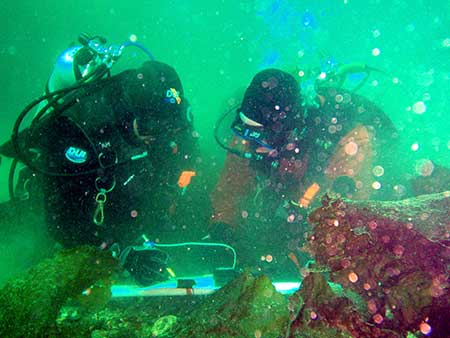
One of the Department of Fish and Game’s (ADF&G) research vessels, the R/V Kestrel, travels around Southeast Region from late March until the middle of September annually as a diving support vessel. The geographic area covers Southeast Alaska from Yakutat to the British Columbia/Alaska border. As the divemaster on board I get the opportunity to work and dive with some pretty talented people. I also get to see and experience some of the most incredible underwater sights. I started recreationally diving in Seattle, Washington in 1980. I have been diving for ADF&G since the spring of 2001, when we dove off a converted tuna troller, the R/V Sundance, which towed our dive skiffs behind the boat. I have been fortunate to be trained as a NOAA Working Diver, NOAA Dive Master, NOAA Dive Medic, a dive instructor and dive safety officer. I love what I do and feel very fortunate to be doing it.
The diving program provides valuable biological data, stock assessment and information to the resource managers from around the Region. It provides valuable resource data for herring managers and also helps the managers make decisions on the sea cucumber, red urchin and geoduck clam fisheries. All the divers are passionate about diving and the fellowship that comes from spending large amounts of time on a boat, and in skiffs together and working underwater where we depend on each other in some challenging conditions. Even with the cold water we are always excited to get in the water and see what unexpected adventure is awaiting us.
Cold Water Diving
Diving in cold water of Alaska is a gear intensive undertaking. Along with warm undergarments, not unlike a union suit made out of a sleeping bag, and a water impenetrable drysuit, divers carry on their backs a Buoyancy Compensation Device (BCD) which carries an aluminum scuba cylinder with approximately 3000 PSI of pressurized air for the diver to breathe underwater. Attached to the top of the cylinder is a regulator setup for us to breathe from, along with a depth gauge, pressure gauge, a suit inflator hose and a redundant air source. There is also a transmitter on the regulator setup that sends signals to our wrist computer that keeps us of apprised of tank pressure, depth and how many minutes we can stay submerged based on depth we are at, work load and our nitrogen accumulation in our tissue and bones. The nitrogen is off-gassed during surface intervals and breaks for lunch. Because dry suits are very buoyant most divers carry 32 pounds in their BCD pockets, four to eight pounds in the shoulder of their BCDs and four pounds around our ankles to keep us submerged.
With all this heavy dive gear on your back and fins on your feet you are hindered in your movement. When the divers are ready and the skiffs in position the divers kneel on each side of the skiff, hop into the water and find them weightless and floating like an astronaut in a very dense environment. I liken it to swimming in a very large aquarium. As you descend to deeper depths the water pressure increases on you (think squeezed like a boa constrictor would) and you add air to your suit with a hose connected to a port located in the center of your chest on your suit to compensate for the increased pressure. As we ascend to the surface at the end of a dive we release air from our suits by an exhaust valve on the left shoulder of our suits.
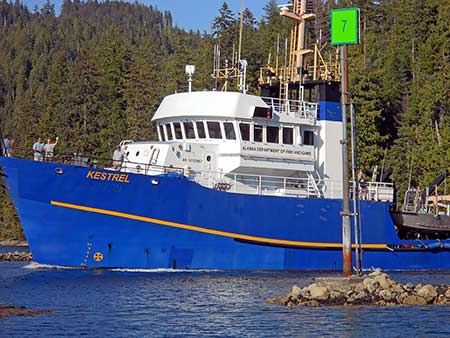
The R/V Kestrel is a very efficient diving platform. We have two Bauer air compressors that fill the 40 scuba cylinders we carry. We fill our tanks with an air mixture of 36% oxygen and 64% nitrogen unlike the 21% oxygen and 79% nitrogen that we all normally breathe. We can change the amounts of oxygen we breathe depending on the projects and the depths at which we are working. The back of the boat has a crane on the stern and the deck has cradles on both sides of the boat that the skiffs sit in when under way. Hydraulic davits lift the skiffs from the cradle to the side of the boat where they are loaded with dive equipment, divers, scuba cylinders and scientific sampling equipment. The skiffs are then lowered in to the water. The hydraulic davits are arm-like pieces of equipment that pivot on the deck. They lift, launch and retrieve the skiffs. There is a 400 gallon gas tank on the stern of the Kestrel that keeps the skiffs supplied. Going from the back deck you walk into a wet lab that is filled with spare dive equipment in totes. The wet lab is filled with many different colored drysuits on one rack and another rack has our drysuit undergarments. We spend the early morning getting ready for the dive day. We chat about the days diving conditions, what to expect during the day and any safety issues that might come up. On a typical dive day we leave the Kestrel at 8:00 a.m., come back for data organization, rewarming and lunch at around 11:30 a.m.. We head back out at about 1:00 p.m. and dive until around 4:30 p.m.. Once back for the day we change into dry clothes and enter the day’s data until 6:00 p.m.. We eat dinner at around 6:00p.m. and the rest of evening is spent reading, playing twister, playing board games, tie-dying or watching a movie.
As the divemaster on the Kestrel, I am on the boat most of the survey season. I really enjoy interacting with all of our divers and guests. It reminds me of summer camp with all kinds of humor, different personalities and many stories about what is going on in people’s lives. The work is physically demanding but the love of diving and the incredible sights make it all worthwhile.
We begin every dive trip by doing a series of underwater safety drills that include flooding and clearing our mask, removing hoses and weight packs and putting them back in their proper place. We also practice scenarios under water where divers take turns pretending they are out of air and then we finish our drills with an injured/unconscious diver at the surface drill. For this drill we remove a “victim” from the water, get him/her into the skiffs and then supply emergency oxygen to the diver. We have extensive 1st aid supplies, backboards, head blocks and straps for the backboards and 15 bottles of 100% oxygen to treat any diving related injuries. 100% oxygen is used to treat any dive related barotrauma (i.e. pressure related injury). To date we have had an excellent safety record. Safety is our number one priority, as diving can be dangerous if not trained and executed properly. The underwater drills we do at the start of every trip are based on things that can happen to us while diving, so we take the time to practice in the shallow water. We had one out of air situation at about 50 feet many years ago. Neither diver panicked and both divers reacted as trained and safely made their way to the surface in a controlled ascent, buddy breathing as they were trained.
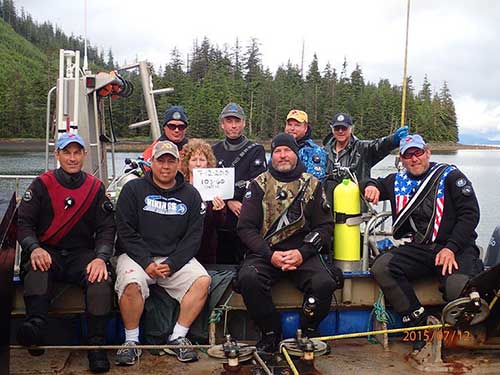
We also train with the U.S. Coast Guard (USCG) from Air Station Sitka and their helicopters several times during our field season. We practice getting an injured diver out of the water, onto a backboard and to the bow of the Kestrel at which time the Coast Guard (CG) helicopter sends down a rescue swimmer. The CG rescue swimmer helps us go through different methods of lifting people off the Kestrel. This is a valuable exercise for us since we work in very remote parts of Southeast. All divers have CPR, First Aid and AED training. All State divers have advanced scuba training, have had rescue diver training and emergency oxygen administration training most of which need to be renewed every two years. We have a pool of 20 divers from around the region. All of our divers love to dive and are excited to get in the water every morning. Some divers have more experience than others, so we pair divers who complement each other’s skills.
The R/V Kestrel is a 105 feet long and 26 feet wide steel boat that ADF&G purchased from the Fisheries and Oceans Canada in 1996. It is crewed by Captain Lito Skeek, engineer Gary Jackinsky and a yet-to-be determined cook/deck hand. The Boat Officers safely and professionally take us to our destinations in sometimes challenging weather conditions. Even though the Boat Officers are not in the dive program we consider them part of our team. We are like a family while we are at sea and we usually enjoy each other’s company.
The Dive Season: Herring
Our dive season starts around the last week in March when we usually head to Sitka for the commercial herring seine sac roe fishery that takes place around the second week of April. While we are in Sitka we perform hydro acoustic surveys of the herring stocks in the greater Sitka Sound area. Hydro acoustic surveys are done by using sectoring sonar to monitor the schools of herring and estimating the size (in tons) of the schools. Once a fishery is announced and opened by the ADF&G management team, the Kestrel will launch one or two of our 19 foot Workskiffs and the crew will sample herring out of successful fishermen’s seine nets. Those samples will eventually find their way to the Mark, Tag and Age lab in Juneau for further analysis in the coming months. These samples will help us determine the age, size and sex ratio of herring in each opening.
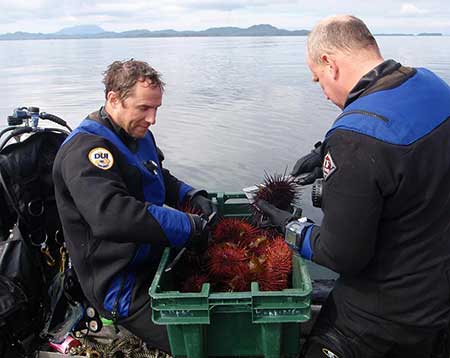
Once the Sitka herring fishery is over and the quota has been caught, the Kestrel begins its travels around Southeast Alaska doing herring spawn surveys. Our usual stops are Craig, West Behm Canal, Ernest Sound, Hobart Bay, Seymour Canal, Tenakee Inlet, Hoonah Sound, Sitka Sound and lastly Berners Bay, north of Juneau. Herring spawn surveys are done using scuba equipment. Throughout the survey season there are usually six divers and two Workskiffs. Each Workskiff will carry three divers suited in warm dry suits. Divers will don scuba gear and swim transects based on where spawn was observed during aerial surveys performed by the Area Management Biologists (AMB) from Juneau, Sitka, Petersburg and Ketchikan.
Herring transects are done by teams of two divers. One diver holds a slate with under water datasheets and the other diver holds a tenth of a meter (0.1m²) quadrat that he/she will lay down every 5 meters and estimate how many herring eggs are on the substrate or in the water column above and below the quadrat. Estimates can range from many thousands eggs to many millions eggs. The most difficult counts are herring eggs on Macrocystis kelp plants that can be 30 foot tall in the water column. Usually the kelp is attached to the ocean floor and the plants grow to the surface. When herring have spawned on the blades of the kelp it often bows under the additional weight, and the kelp lays over until the eggs develop and hatch in about two weeks.
The herring divers are calibrated every spring to determine if they consistently underestimate or overestimate their counts in a quadrat. The factor by which their estimates are over/under is applied to all of the data collected for each herring transects that the diver completes. Herring diving is some of the most laborious diving we do, since it is usually cold above and below the water and the visibility is often poor. Visibility can range from 3 feet at times to 40-50 feet on a great day. Herring work usually is over around the middle of May at which point the Kestrel transitions to sea cucumber, geoduck clams and red urchin survey work. Spring is a great time to be on the water in Southeast Alaska as the birds, sea lions and humpback whales are returning to feast on the herring that have moved into the shallow waters to spawn.
Sea cucumber, Geoduck Clams and Red Urchin Surveys
Sea cucumber, geoduck clams and red urchin surveys have different protocols. Most of our diving is for sea cucumber surveys, which is used to set the harvest guidelines for the coming fall season. Commercial cucumber divers in scuba gear run around on the bottom of the ocean and gather sea cucumbers for two days a week starting the first week of October and usually finish around Thanksgiving. Sea cucumber surveys are done with two divers; each diver has a two meter PVC transect rod that has a compass, depth gauge and a data sheet attached. The divers’ jump into the water at predetermined transect points and swim perpendicular to the shore line to 50 feet of sea water plus or minus the tide correction. Divers swim along the sea floor looking for sea cucumbers. Divers count every cucumber that falls under the transect rods and sometimes transects are covered in 100% kelp, which the divers will have to paw through to get an exact count. Red urchins and geoduck clam surveys are done doing similar types of transects, but using a one meter transect rod instead.
Combating Invasive Species
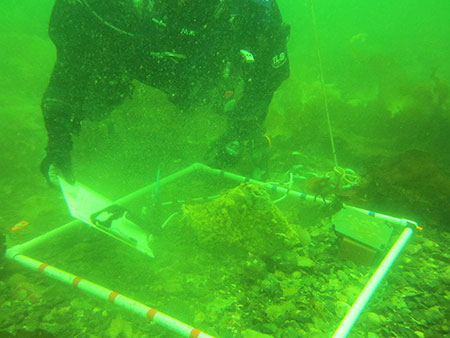
In addition to sea cucumber, red urchin and geoduck clam surveys we have also started working with the Sitka Sound Science Center (SSSC) and National Marine Fisheries Service conducting pinto abalone surveys and setting up Abalone Recruitment Modules (ARMs) in several areas of Southeast Alaska. We also work with the State of Alaska Department of Fish and Game invasive species coordinator Tammy Davis, investigating methods to control an invasive tunicate (Didemnum vexillum) in Whiting Harbor near Sitka. We have twice surveyed Whiting Harbor to determine the extent of the invasion and this past summer we had two trips where we worked with the Smithsonian Environmental Research Center (SERC) divers and their lead scientist. We experimented with different treatment options, lime, salt and chlorine. Along with SERC folks we were joined by representatives of the Bureau of Land Management and a fisheries biologist from ADF&G Sportfish Division. The work in Whiting Harbor has been called cutting edge science because it has not been attempted elsewhere. We’re very excited to be helping them in the endeavor. We hope to be doing additional work with them over the next couple of years to try and stop the invasion before it spreads to other areas.
American Academy of Underwater Sciences
In the fall of 2014 we helped facilitate, along with the University of Alaska Southeast, the annual symposium of the American Academy of Underwater Sciences (AAUS) in Sitka. The AAUS is a non-profit, self-regulating body dedicated to the establishment and maintenance of standards of practice for scientific diving. The AAUS is concerned with diving safety, state-of-the-art diving techniques, methodologies, and research diving expeditions. It was a great opportunity to have scientific divers from all over the world come to Sitka. We had six vessels operated by experienced ADF&G divers, and we took AAUS divers to some of our favorite dive sites in Sitka Sound. A couple of divers wanted to see whales while they were in the skiff and a couple of divers from large cities just wanted to look at the big spruce and hemlock trees that grow very close to the waterline. They all had a great time thanks to the organization and patience of the ADF&G personnel. We were all proud of how well it all went and were pretty exhausted from all the effort.
Jeff Meucci has over 5,700 dives in Southeast Alaska; he is the Commercial Fisheries dive master on the Kestrel. He loves to dive and gets cranky when he is not in the water every day during the survey season. He dreams of warm water adventures and loves helping people discover the wonders of the ocean.
Subscribe to be notified about new issues
Receive a monthly notice about new issues and articles.
